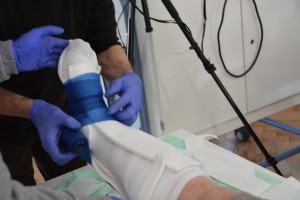Agreements about therapy that are impossible to be put into practice in everyday life and blaming the patient in the case of failure of this therapy are frequent with the DFS. Less experienced therapists often use the word ‘non-compliance’ to describe patient’s attitude from their point of view. Alternative recommendations relate to communication and technical aspects of offloading.
Exploring the Patient’s Needs
Individually tailored therapy goals increase the chance of being met. People who love to run, shoe lovers, barefoot walkers… – it is a legitimate but demanding task to find the ideal solution for everyone. Aesthetic aspects are thereby respectable needs, because the clothes are experienced as part of the person. In a broader concept of a person’s health it might be wise not to wear ugly things, at least if the person isn’t completely convinced of this necessity. This would exclude exceptions, which is something seldom true and hard to accept.
That does not mean that a clear language is wrong, on the contrary. What is not possible must be transported clearly. But the patient’s question ‘isn’t there something nicer?’ is completely legitimate and should be considered seriously.
Questions about typically difficult situations show the therapists interest in a conversation without taboos: What is your plan if you need to go to the toilet at night in a hurry without stepping on the wound? What do you do when you shower / get out of the shower? What would you wear for a very important occasion / the ‘most important date of your life’?
Technical Alternatives
Having ‘many arrows in the quiver’ helps in choosing from more options in individual cases. Methods of pressure redistribution with felt or the surgical correction of malpositions are examples of techniques that are often ignored. A good overview of all these technical alternatives can be provided by the concept of entities. They are the subject of courses on the use of felt and medical training.
Generally speaking, methods that involve the patient’s decision to be worn have to include compromises and often are not put into practice even after long discussions and adaptions to the patient’s needs. On the other hand, unremovable devices and surgical procedures work without these continuous decisions and have therefor important advantages. They should be the preferred options in the case, dramatic consequences are threatening the patient.
Changing the Perspective
It sounds natural: Do not agree anything that you suspect will not be implemented. The perspective of the acting person is decisive. Accept the inevitable without feeling bad.
Consider three times whether it is necessary to walk ‘little’, ‘only the most necessary’ or ‘hardly at all’.
Force yourself to consider carefully why misalignments should not be corrected by tendon interventions if ulcers are incombing or are already present.
In the event of deterioration, do not ask whether patients walked too much or if shoes other than those agreed upon have been worn. A better question for the patient would be: ‘What can we do better’ and for the practitioner ‘Are there alternatives?’
The failure of a treatment concept is exactly that and nothing more. It is neither a failure of the therapist nor that of the patient. It should lead to a change in this concept and not to an intensification of motivation.


